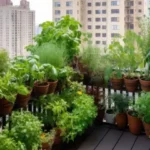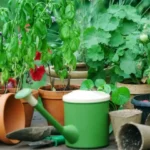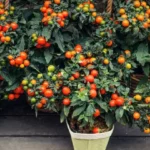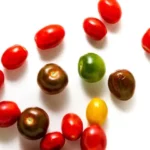Consider growing potatoes in buckets with straw to optimize your spud cultivation process. This innovative approach offers a controlled environment that fosters healthy tuber development. By utilizing simple materials and following specific steps, you can greatly enhance your potato harvest.
Growing potatoes in buckets with straw can yield a good harvest of potatoes in a small space, and the straw helps to keep the soil moist and suppress weeds. It is a popular and efficient way to cultivate potatoes in a small space. Here’s how you can do it:
- Choose a Bucket: Use a large, sturdy bucket or container with drainage holes at the bottom. A 5-gallon bucket works well for growing potatoes.
- Prepare the Bucket: Fill the bottom of the bucket with a few inches of soil or compost for drainage.
- Planting: Place seed potatoes (whole or cut into pieces with at least 2-3 eyes per piece) on top of the soil, spaced evenly. Cover with a few inches of straw.
- Add Straw: Add straw around the stems, covering the plants thoroughly as the potato plants grow. Leave a few inches of the plant exposed at the top. (Repeat this layering as your plants mature).
- Watering: Keep the straw moist but not waterlogged. This method can be challenging to water, so monitor moisture levels closely.
- Harvesting: Potatoes can be harvested once the plants have flowered and died back. Remove the straw and carefully dig around the base of the plant to find the potatoes.
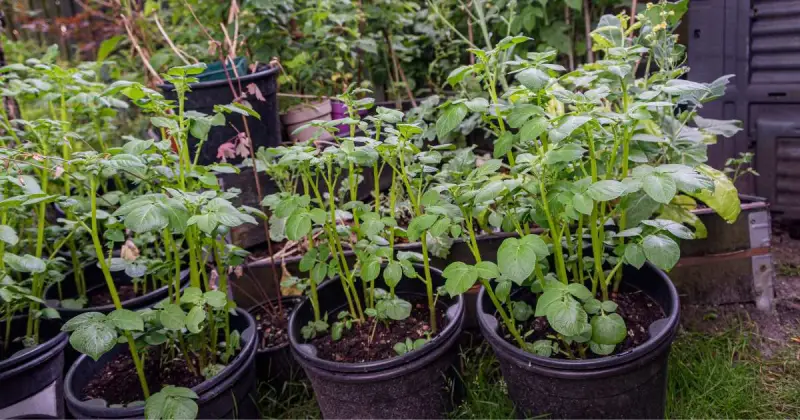
Growing spuds should be fun and rewarding—no matter your experience level. Imagine the convenience of harvesting your own home-grown potatoes right from a humble bucket. Stay tuned to discover the secrets behind this simple, intriguing gardening technique, which produces fantastic yields.
Humble Highlights
- Discover the unique benefits of cultivating potatoes in buckets and straw and grow vertically so you can make efficient use of limited garden space – perfect for urban gardeners!
- Save time with these done-for-you watering and maintenance tips and uncover how straw can help reduce the risk of pest infestations as it acts as a barrier and can deter pests, so you can grow your spuds with confidence!
- Uncover these 4 crucial harvesting and storing tips so you can help your potatoes stay fresh long after harvesting AND know what fruits they should never be stored near!
Benefits Of Growing Potatoes In Buckets
Growing potatoes in buckets offers numerous advantages, making it a practical and efficient method for cultivating this staple crop. You provide a controlled environment for your potato plants, reducing the risk of diseases like potato blight, which can occur in traditional garden settings.
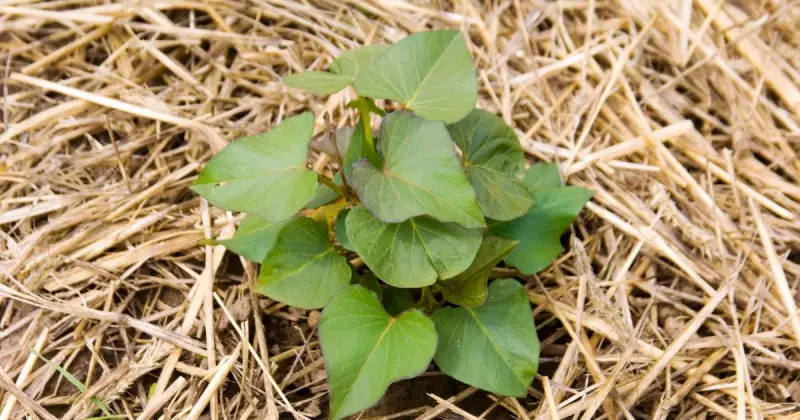
The confined space of the bucket encourages the plants to focus their energy on tuber production rather than excessive foliage growth. This method also allows for easy monitoring and maintenance of the plants, ensuring ideal conditions for growth.
Harvesting potatoes from buckets is straightforward. As the potatoes are contained within the bucket, you can tip it over to harvest them, avoiding digging through the soil as you’d in traditional raised beds. 1
Additionally, adding straw provides excellent insulation for the tubers, protecting them from extreme temperatures and promoting even growth. This method offers convenience, efficiency, and exceptional control over the potato-growing process.
Materials Needed For Bucket Cultivation
To set up your bucket cultivation for growing potatoes, gather 5-gallon buckets, seed potatoes, potting soil, and straw. Select a location that receives at least 6-8 hours of sunlight. You’ll also want to ensure the buckets have drainage holes in the bottom to prevent water accumulation, which can lead to root rot.
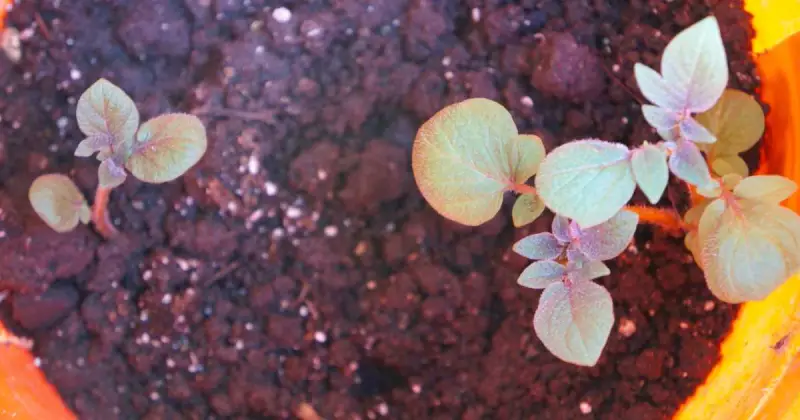
Start by layering the bottom of the bucket with 4-6 inches of soil, which acts as the growing medium for the potatoes. Place 3-4 seed potatoes with sprouts facing up and cover them with more straw. 2
As your plants grow, you’ll repeat this alternating layering between potting soil and straw, which is called bird nesting. Remember to water the bucket regularly to maintain the straw’s moisture level without letting it become waterlogged.
Following these steps will help create a conducive environment for the tubers within the 5-gallon buckets that benefit from the insulation and protection the straw provides.
Growing potatoes in buckets with straw can also help reduce the occurrence of certain potato pests and diseases. The straw acts as a barrier, making it more difficult for pests like potato beetles to access the plants.
Additionally, straw can help regulate soil temperature, keeping it cooler in hot weather and warmer in cool weather. This can benefit potato plants and promote healthy growth, especially if your region is prone to wild temperature swings.
Growing potatoes in buckets with straw can be practical and effective, especially in limited space or challenging growing conditions.
Steps To Planting Potatoes In Straw
Prepare your seed potatoes by warming them to 75 degrees Fahrenheit and cutting larger ones into pieces with two or three eyes. When planting potatoes with both soil and straw, follow these steps:
- Plant sprouted seed potatoes in soil and cover with several inches of soil and straw.
- Water weekly if no rain occurs, and add more soil and straw as sprouts grow.
- Stop watering when sprouts begin to die back, and harvest potatoes when sprouts have completely died back. 3
- Store harvested potatoes in a cool, dark place, like a root cellar. Monitor them regularly for signs of sprouting or rot, and discard any that do.
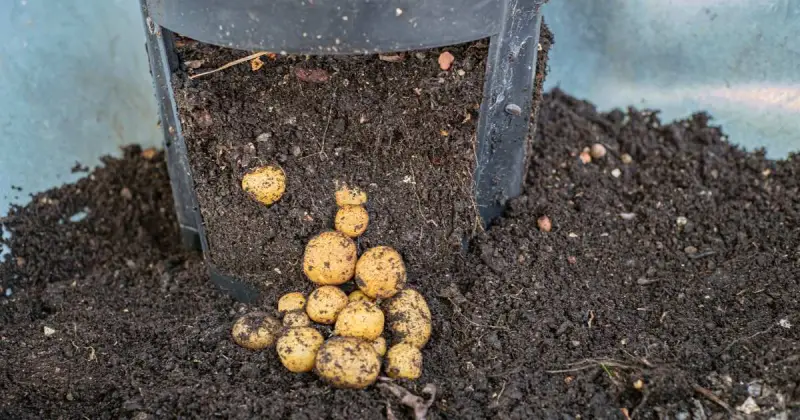
Providing the right conditions and care is essential for successfully growing and storing potatoes. Following these steps will help you maximize your potato harvest and ensure they stay fresh for longer periods.
Utilizing straw during potato growth has several essential benefits, including:
Weed Suppression: The straw mulch helps suppress weeds, reducing the need for frequent weeding.
Moisture Retention: The straw helps retain moisture in the soil, reducing watering frequency.
Temperature Regulation: The straw insulates the soil, keeping it cooler in hot weather and warmer in cool weather, which can benefit potato growth.
Pest and Disease Prevention: Growing potatoes in containers with straw can help reduce the risk of pest infestations and certain diseases.
Improved Soil Structure: As the straw breaks down, it adds organic matter to the soil, improving its structure and fertility over time.
Watering And Maintenance Tips
Maintain consistent watering of the straw-filled buckets to sustain ideal moisture levels for healthy potato growth while avoiding waterlogging and potential plant diseases. Water the buckets regularly, ensuring the soil surface remains damp but not waterlogged throughout the growing season. Monitor the moisture content of the straw and soil, adjusting your watering frequency accordingly, especially during the late season when potatoes require more water.
Here’s a helpful table to guide you in your watering and maintenance routine:
| Watering and Maintenance Tips | Description |
|---|---|
| Check soil moisture regularly | Ensure the soil’s surface remains moist, not waterlogged |
| Mulch with straw | Helps retain moisture, regulate temperature, reduce weeds |
| Monitor drainage | Prevents water accumulation and root rot |
These simple steps will help you grow potatoes in buckets, but remember to inspect your plants frequently for signs of pests, diseases, or nutrient deficiencies to maintain their health and maximize your harvest. 4
Growing potatoes with straw helps to keep the soil cool, retain moisture, and protect the developing potatoes from sunlight, making potato cultivation more convenient. It’s also an efficient way to grow this versatile crop, especially for those with limited space or poor soil conditions. Check out the video below that explains how easy this method is!
Harvesting And Storing Your Potatoes
When your potato plants exhibit yellowing foliage and wither, it’s a sign of maturity and a time to harvest your bucket-grown potatoes. Here are some essential steps for harvesting and storing your potatoes effectively:
- Use a garden fork or your hands to gently dig out the potatoes from the straw, careful not to damage them.
- Allow the freshly harvested potatoes to dry in a shaded, well-ventilated area for a few hours to cure and toughen their skins.
- To prolong their shelf life, store the cured potatoes in a cool, dark, and well-ventilated place, such as a basement or pantry.
- Check stored potatoes regularly for any signs of sprouting, soft spots, or rot, and remove any affected ones to prevent spoilage.
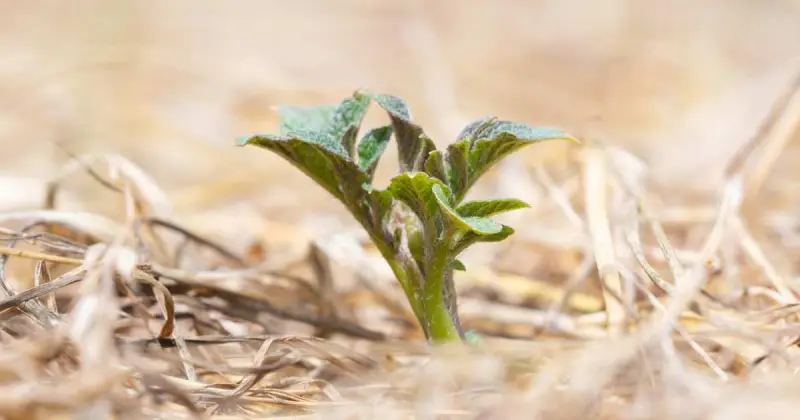
Proper harvesting and storage practices are essential to ensure your potatoes stay fresh and edible for an extended period. By following these steps diligently, you can enjoy the fruits of your labor long after the harvesting season. 5
Homegrown potatoes should be stored away from fruits that release ethylene gas, such as apples, bananas, and tomatoes. Ethylene gas can cause potatoes to sprout and spoil more quickly.
You’ll also want to avoid storing potatoes in the refrigerator. The cold temperatures can convert the potato starches into sugars, affecting their flavor and texture.
Conclusion
Cultivating potatoes in buckets with straw is a practical and efficient method for controlled growth in limited spaces. By following the steps outlined, you can easily plant, water, maintain, and harvest your potatoes.
This innovative approach reduces the risk of disease issues and promotes healthy tuber production over excessive foliage growth. Consider trying this method for a convenient and productive potato harvest.
Do you cultivate potatoes in buckets and straw? We’d love to hear your story. In the comment section below, tell us your successful steps and if they are different from the ones we covered here!
SOURCES
- Low Technology Institute – Research Project No. 2 – Comparing Potato-Growing Methods
- MDPI – Sustainable Potato Growth Under Straw Mulching Practices
- Oregon State University – Grow Your Own Potatoes
- University Of New Hampshire – What Is The Best Way To Grow Potatoes In Containers?
- University Of Nebraska-Lincoln, Institute Of Agriculture And Natural Resources Extension – Potatoes: Harvesting And Storing (potatocare)

